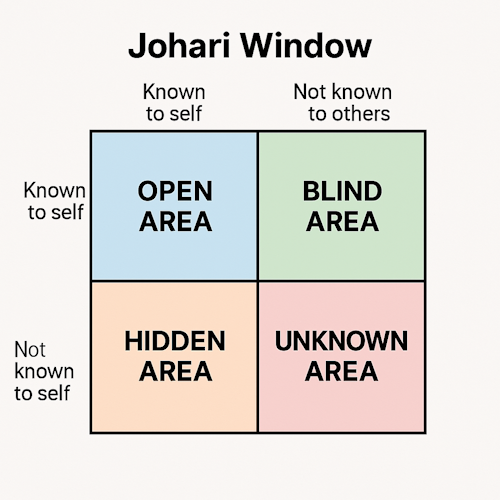Johari Window
Team awareness expands through feedback and disclosure.
"Knowing yourself is the beginning of all wisdom."

In Agile environments, collaboration is currency - and trust, transparency, and feedback are the foundations of that currency. The Johari Window, a psychological model created by Joseph Luft and Harrington Ingham (who named their model using a combination of their first names), helps individuals and teams understand the dynamics of self-awareness and interpersonal perception. It's a practical framework for Agile coaches to increase alignment, surface dysfunctions, and cultivate high-performing teams.
The Johari Window consists of four quadrants, each representing different aspects of self-awareness and interpersonal dynamics:
| Quadrant | Description |
|---|---|
| Arena/Open Area | Known to self and others |
| Façade/Hidden Area | Known to self but hidden from others |
| Blind Area | Unknown to self but known to others |
| Unknown Area | Unknown to both self and others |
In Agile teams, the size of each quadrant shifts as people give feedback, disclose thoughts, and build relationships. Effective teams work to expand the Open Area, where trust and shared understanding thrive.
Impact on Agile Teams and Organizations
Agile relies on collaboration, feedback loops, and adaptability. The Johari Window helps:
- Foster self-awareness and mutual understanding.
- Reveal blind spots that hinder communication or performance.
- Encourage a culture of trust and openness.
- Reduce siloed thinking and unspoken assumptions.
- Strengthen feedback practices in Retrospectives and team health checks.
Teams with large "Open Areas" tend to communicate better, collaborate more effectively, and adapt faster - core principles of Agile.
Scenario
A cross-functional Scrum team is struggling. Stand-ups are quiet, Retrospectives surface few issues, and velocity is erratic. A coach observes that team members rarely give feedback, and one developer is consistently misunderstood by others.
Analysis through Johari Window:
- The developer has a large Blind Area. Others notice habits affecting team dynamics (e.g., dismissive tone, delayed responses), but the developer is unaware.
- Team members have large Hidden Areas. Fearing judgment, they keep concerns and ideas to themselves.
- The Open Area is small, limiting psychological safety and transparency.
This misalignment causes friction, poor collaboration, and missed opportunities for improvement.
Ways to Mitigate:
To improve self-awareness and transparency in Agile teams:
- Expand the Open Area:
- Encourage open communication through regular 1:1s, Retrospectives, and feedback circles.
- Use team agreements or working agreements to define safe boundaries for openness.
- Reduce the Blind Area:
- Promote constructive feedback with practices like Start-Stop-Continue, Feedforward, and radical candor.
- Use tools like 360° feedback or team radars to reveal blind spots gently.
- Shrink the Hidden Area:
- Foster a culture of psychological safety where individuals feel safe to be vulnerable.
- Lead by example. When leaders and Scrum Masters share openly, others follow.
- Explore the Unknown Area:
- Embrace experimentation and coaching to discover untapped strengths and resolve hidden blockers.
- Try pair programming, job shadowing, or cross-training to unearth latent skills and improve team resilience.
Conclusion:
The Johari Window is more than a psychological theory, it's a practical lens to understand Agile team behavior. By making the Open Area larger, teams build trust, resolve conflict faster, and adapt more effectively. As Agile coaches, helping teams navigate these quadrants is crucial for fostering high performance and continuous learning.
Key Takeaways
- Self-awareness and transparency are critical for Agile success.
- The Open Area enables effective communication and collaboration.
- Blind Spots and Hidden Areas can cripple team trust and productivity.
- Feedback, psychological safety, and experimentation shrink the unknowns.
- Agile Coaches play a key role in expanding awareness and trust within teams.
Summary
The Johari Window offers a compelling way to understand and improve interpersonal dynamics within Agile teams. By identifying what's known and unknown, both individually and collectively, teams can create an environment of trust, open feedback, and continuous improvement. Expanding the Open Area becomes a catalyst for agility, adaptability, and stronger team culture.